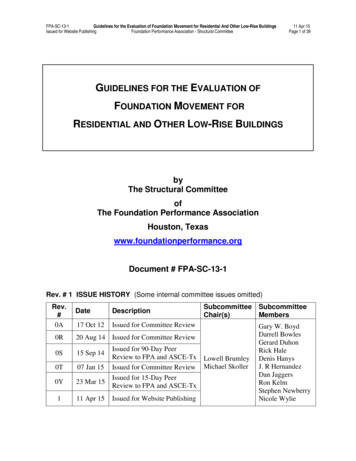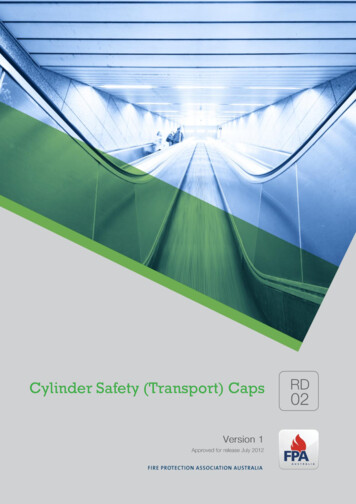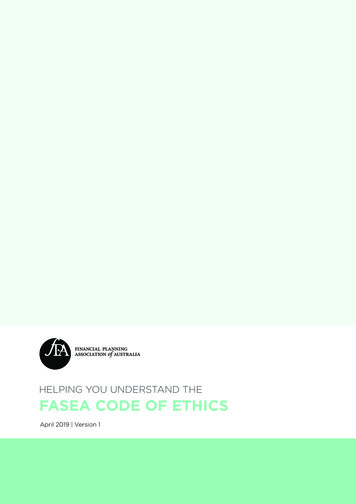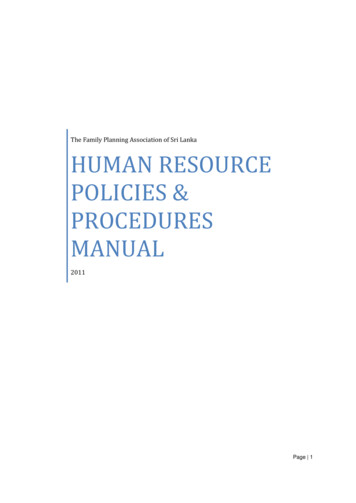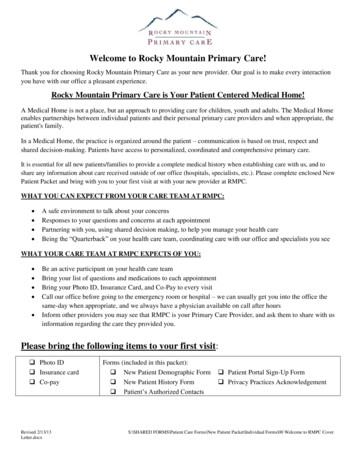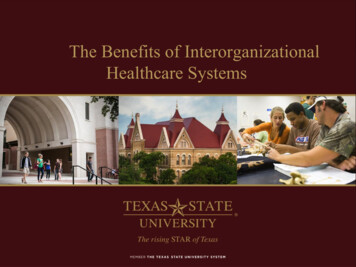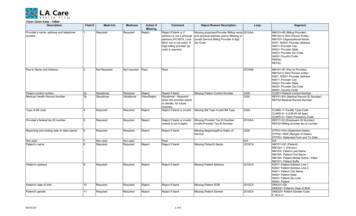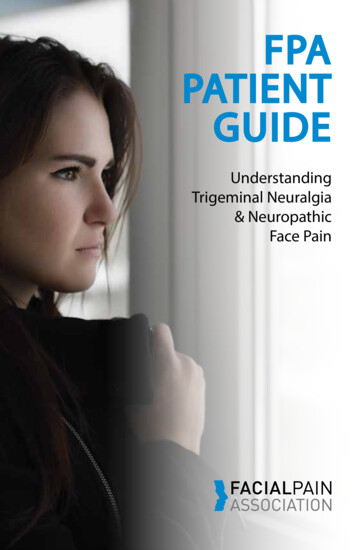
Transcription
FPAPATIENTGUIDEUnderstandingTrigeminal Neuralgia& NeuropathicFace PainA
Welcome to the Facial Pain AssociationThere are more than 4.3 million people in the United Statesafflicted by nerve generated facial pains. At the extreme endof this spectrum of disorders, classic trigeminal neuralgia (TN),commonly referred to as the most painful affliction known tomedical science, strikes erratically with sharp shocks of pain.Allison Feldman,CEOAlthough described as early as the first century by Greek andRoman physicians, TN and related facial pain remains a poorly understood and often misdiagnosed disease with nopermanent cure.The Facial Pain Association (FPA), a 501 (c) (3) non-profit health organization,was founded in 1990 as the Trigeminal Neuralgia Association. We have evolvedover the last 30 years into the world’s largest organization providing education,support and advocacy for patients with TN and related facial nerve pain.The FPA website, facepain.org, is the leading resource on the web for peoplewith facial pain. Our toll free telephone line (800-923-3608) provides one-onone support from a skilled patient services coordinator. We also maintain aPatient Support Network that provides local contacts throughout the USA,Canada, the United Kingdom, Europe and Australia, as well as a web basedinteractive community of people with facial pain from around the globe.We hope you find this resource guide to be an invaluable tool for understandingyour diagnosis and helping you to determine your treatment plan. Be aneducated patient; understand your options, take advantage of our supportnetwork, learn to manage this disease so it does not manage you.Tips for Caregivers .13. 13Dental Guide .1414Tips for Young Patients .15. 15Frequently Asked Questions .1717Web and Social Media Resources .19. 19Become a Member/Support the FPA .2020February 2020Content. Page NumberContent.TN Classifications . 2Is There a Test? . 4Treatments for TN and Neuropathic Face Pain . 7Surgical Alternatives . 9
Understanding TrigeminalNeuralgia & NeuropathicFacial PainThe trigeminal nerve is the 5th cranial nerve that supplies sensation tothe face, eyes, nose, lips, teeth, gums, anterior portion of the tongue andpart of the scalp. In classic trigeminal neuralgia (TN) as the nerve exits thebrainstem it is often compressed by a blood vessel. This compression resultsin a lesion in the myelin coating. Because of this lesion the brain is receivingand sending crossed signals that result in sudden shock-like pain in the areainnervated by the trigeminal nerve.Classic TN has distinct symptoms which clearlyseparate it from other forms of neuropathic facial pain. Classic TN is usually unilateral pain, only occurring bilaterally in 4%of people diagnosed with TN The pain comes in short, acute bursts, rather than in a dull,constant ache. Pain is usually triggered by light touch or sensitivity to vibrations,like brushing teeth, shaving, a light breeze, talking, etc. Pain has a tendency to come and go with periods of intense painfollowed by complete pain-free periods of remission lasting fromweeks to months or longer.All maladies that effect the trigeminal nerve are not considered trigeminalneuralgia (TN). Often it proves difficult for the physician and patient todetermine the fine differences between classic TN and other types ofneuropathic face pain. In order to decide on the proper treatment plan itis imperative to recognize these differences. Therefore, it is important tounderstand the various classifications to assure a proper diagnosis.Symptoms of Trigeminal Neuropathic Pain that is not TN: Occurs soon after unintentional injury to the trigeminal system The pain is better described as constant, dull, burning or boring pain withintermittent sharp pain. A destructive procedure used for classic TN could make neuropathic painmuch worse.1
Classification of neuropathic facial painPrinted with permission from the Mayfield Clinic. Classic Trigeminal Neuralgia, type 1, (TN1) (also known as ticdouloureux): is facial pain of spontaneous onset with greater than50% of the pain occurring during a limited episode of pain (temporarypain). TN1 is often caused by loss of or damage to the nerve’sprotective coating, (myelin). The most widely accepted view is thatmyelin damage results from irritation of the nerve, usually a bloodvessel that causes the nerve to be compressed. Trigeminal Neuralgia, Type 2, (TN2): facial pain of spontaneous onsetwith greater than 50% of the pain being constant. Secondary Symptomatic Trigeminal Neuralgia (STN): Pain resultingfrom another condition such as a tumor or multiple sclerosis. Post- Herpetic Neuralgia (PHN): pain resulting from a herpes zosteroutbreak (shingles) along the trigeminal nerve.2
Mayfield Clinic Classification con’t. Trigeminal Neuropathic Pain (TNP): facial pain resulting fromunintentional injury to the trigeminal system from facial trauma, oralsurgery, ear, nose and throat (ENT) surgery, root injury from posteriorfossa or skull base surgery, stroke, etc. This pain is described as dull,burning, or boring and is usually constant because the injured nervespontaneously sends impulses to the brain. The injured nerve is alsohypersensitive to stimulation, so attacks of sharp pain can also bepresent. The area which is sensitive to touch and triggers these sharpattacks is the same area where the pain occurs. Numbness and tinglingare also signs of a damaged nerve. Trigeminal Deafferentation Pain (TDP): facial pain in a region oftrigeminal numbness resulting from intentional injury to the trigeminalsystem from neurectomy, gangliolsys, rhizotomy, nucleotomy,tractotomy, or other denervating procedures. Despite the loss ofsensation, constant pain is felt in the numb area(s), which varies inintensity and can include sensations of burning, crawling, tingling,boring, stinging, and/or unpleasant aching.3
Is there a test to diagnose TNand other forms of neuropathicfacial pain?Neuropathic facial pain is diagnosed almost exclusively by theindividual’s description of the symptoms. Dr. Kim Burchiel, on staff atOHSU Brain Institute, has developed a list of questions to help doctorsdetermine exactly which classification may describe a patient’s pain. Youmay want to complete the Burchiel Questionnaire for your physicianas a way of helping to determine the correct pain classification. Thisquestionnaire in the hands of experienced neurologists and neurosurgeonscan be very powerful.1) When you have pain, is it predominately in your face (i.e.forehead, eye, cheek, nose, upper/lower jaw, lips, etc.)?2) Do you have pain just on one side of your face?3) Is your pain either entirely or mostly brief (seconds to minutes)and unpredictable sensations (electrical, shocking, stabbing,shooting)?4) Do you have constant background facial pain (aching, burning,throbbing, stinging)?5) Do you have any constant facial numbness?6) Can your pain start by something touching your face (e.g. byeating, washing your face, shaving, brushing teeth, etc.)?7) Since your pain began, have you ever experienced periods ofweeks, months or years when you were pain-free? (This doesnot include periods after any pain relieving surgery or whileyou were on medications for your pain.)8) Have you ever taken Tegretol, Neurontin, Baclofen, Trileptal orother anti-seizure drugs (AED’s) for your facial pain?9) Did you ever experience any major reduction in facial pain(partial or complete) from taking any of these AEDs?4
10) Have you ever had surgery for your pain? (e.g. neurectomy,radiofrequency, lesioning, glycerol injection, ballooncompression, rhizotomy, microvascular decompression orradiosurgery)11) Did your current pain start only after trigeminal nerve surgery?If this is a recurrence of your original pain after successfultrigeminal nerve surgery, the answer is, “no”.12) Did your pain start after facial herpes zoster or “shingles” rash(not merely “fever blisters” around the mouth)?13) Do you have multiple sclerosis?14) Did your pain start after a facial injury?15) Did your pain start only after facial surgery (i.e. oral surgery, ear/nose/throat surgery or plastic surgery)?16) When you place your index finger right in front of your ears onboth sides at once and feel your jaw open and close, does thearea under your fingers on either side hurt?5
Diagnosis Through ImagingDoctors typically order an MRI scan when TN is suspected, in order torule out multiple sclerosis or a tumor and look for an offending vesselthat might be causing the pain.Special MRIs, known as high-resolution, thin-slice or three-dimensional(3D), have demonstrated the ability to predict fine trigeminalneurovascular compression. Newer more finite scans might show anartery pressing on the nerve, but not always a vein. Moreover, someimages can be used to determine the “degree” of compression. Be sureto get this type of MRI.Commercial names for high resolution images are:Steady-State Free Precession (SSFP)GE: FIESTA (Fast Imaging Employing Steady-state Acquisition)Siemens: FISP (Fast Imaging with Steady-state Precession)Philips: FFE (Fast Field Echo), b-FEE (Balanced Fast Field Echo)Note: Recent information suggests that many people havecompression of the nerve, but do not develop TN. The existence ofcompression alone should not be the only reason for surgery.6
Will TN or facial pain go awayon its own?Sometimes, but it’s not likely. TN pain typically runs in cycles, it is commonfor individuals with TN to experience periods of remission. Remission can lastfor weeks, months, and even years. Over time, the attacks tend to worsenwith fewer and shorter pain-free periods. Other forms of neuropathic facialpain do not usually go completely away.Treatment of Neuropathic Facial PainOnce you and your doctor have determined the appropriate diagnosis,medication will usually be the first line of treatment. Anticonvulsants,which slow down the nerve’s conduction of pain signals, will most likelybe prescribed first. In trigeminal neuralgia and several other forms ofneuropathic facial pain, the pain is of lightning like intensity and the attacksare of brief duration, therefore analgesics, i.e. aspirin, Tylenol, Ibuprofen, etc.and narcotics are not usually effective in addressing the pain.In trigeminal neuralgia, Carbamazepine (Tegretol, Carbatrol, Epitol) is oftenthe most effective treatment. Initial relief with Carbamazepine is so readilyachieved that many physicians consider its use as a means to confirm thediagnosis of TN. The drug is introduced slowly and increased to a level wherethe patient is pain-free or side effects occur.MedicationAnticonvulsants such as: Carbamazepine (Tegretol), Oxcarbazepine(Trileptal), Phenytoin (Dilantin, Phenytek), Gabapentin (Neurontin, Gralise),Lamotrigine (Lamictal). Other drugs, including Clonazepam (Klonopin) andLacosamide (Vimpat) also may be used.Antidepressants: Tricyclic antidepressants: (Amitriptyline)Antispasmodic agents: Muscle-relaxing agents such as Baclofen (Gablofen,Lioresal) may be used alone or in combination with Carbamazepine. Sideeffects may include confusion, nausea and drowsiness.Opioids are helpful in some cases of trigeminal neuropathic anddeafferentation pain.Anti-depressants or drugs that may help stop seizures are onlybeing prescribed because of the way that they can also stop painbeing felt within the body. They are not being prescribed becausethe patient is either depressed or potentially will have seizures,it is their pain control role that is being used here, nothing to dowith their primary function. In a sense their pain control is a ‘byproduct’ and it is the by product which is being used.7
Managing MedicationPlease advise your medical professional of any other prescriptionmedications, over-the-counter medications, “herbals,” dietary supplements,etc., that you are taking. Adverse drug events are linked to polypharmacy. Ifyou require opioid medications, the prescribing physician should considerthe potential for metabolic drug-to-drug interactions which can causeserious adverse reactions that can be fatal.If the anticonvulsant you are using begins to lose effectiveness, yourdoctor may increase the dose or switch to another type. Side effects ofanticonvulsants may include dizziness, confusion, drowsiness and nausea.Also, Carbamazepine can trigger a serious drug reaction in some people,mainly those of Asian descent.During all phases of medical treatment, patients need to communicate theirpain level and/or drug side effects to their healthcare professional, so thatmedications can be regulated effectively.8
Surgical alternatives for TNPLEASE NOTE that the surgical treatments listed are for Trigeminal Neuralgia(TN1 and TN2) and Symptomatic Trigeminal Neuralgia (STN), caused fromMS.These surgical procedures are not useful for Related Facial Pain such as:Trigeminal Neuropathic Pain (TNP), Trigeminal Deafferentation pain (TDP)and Post-herpetic Neuralgia (PHN).Non-ablative (non nerve damaging)Microvascular Decompression Surgery (MVD): The MicrovascularDecompression (MVD), was designed to cause no additional nerve damageand offers the best chance of long-term relief. The surgeon enters the brainat the base of the skull and relieves the compression. The nerve is wrappedin a Teflon-like material and the opening to the skull is closed.Ablative (damaging the nerve)Several procedures can be done to stop the transmission of pain signals tothe brain. These procedures actually cause damage to the nerve and can beeffective for varying lengths of time. Procedures that go through the cheekwith a needle (percutaneous) are glycerol injections, balloon compression,and radiofrequency lesioning. These treatments can be done in the X-raysuite or operating room. Balloon Compression is an outpatient procedure, although sometimesthe patient has an overnight hospital stay. It is performed in the operatingroom, with the patient receiving general anesthesia. In this percutaneousprocedure, a cannula is inserted through a puncture in the cheek andguided to a natural opening in the base of the skull. A soft catheter witha balloon tip is threaded through the cannula. The balloon is inflated,squeezing the nerve against the edge of the dura and the petrous bone.Balloon compression works by selectively injuring nerves which mediatelight touch. Glycerol Injection is also an outpatient or overnight procedure. It isperformed with intravenous sedation. A thin needle is introduced througha puncture in the cheek, next to the mouth and guided through a naturalopening in the base of the skull. Just inside this opening is the trigeminalganglion where all three nerves come together. Glycerol bathes theganglion and affects the demyelinated fibers.9
Radiofrequency lesioning is usually performed in an outpatient setting. Thepatient is sedated for a few minutes while a needle is passed through thecheek, up through a natural opening in the base of the skull. The patient isawakened and a small electric current is passed through the needle causingtingling. When the needle is positioned so the tingling occurs in the samearea of TN pain. The patient is sedated again and a radiofrequency current ispassed through the needle to intentionally destroy part of the nerve. Radiosurgery (GammaKnife, CyberKnife) is a non-invasive procedureperformed on an outpatient basis; it requires no incision but may requirethe attachment of a head frame. Highly focused beams of radiation aredirected to the area where the trigeminal nerve exits the brainstem. Theradiation causes the slow formation of a lesion on the nerve that disruptsthe transmission of pain signals to the brain. However, pain relief from thisprocedure may take several months.The majority of people with TN may find relief with pharmaceutical and/or surgicalprotocols. A significant number of people have persistent facial pain from dentalprocedures, auto accidents, sports injuries, exposure to toxic chemicals and otherunknown causes. For these patients, the standard medical and surgical protocolsare often inadequate.Other treatmentsMotor cortex stimulation is a type of neuromodulation used forneuropathic and deafferentation facial pain. This is a surgical procedure thatimplants electrodes in the body to change how the nervous system works.Motor cortex stimulation involves placing the electrodes on the surface ofthe brain to control pain signals. It is an off-label procedure, which means itis not yet FDA-approved.Deep brain stimulation is more complex than motor cortex stimulationbecause it involves implanting a device deep inside the brain rather than onthe surface of the brain.With all of these surgical procedures, there is the possibility of TN returning. Thereis a slight chance of numbness with MVD. Some degree of numbness is expectedin the other procedures, as well.10
Complementary and alternativemedical (CAM) treatments:Many people find CAM options that offer some relief. These therapiesinclude things like Acupuncture, Biofeedback, Capsaicin, Homeopathy,Nutritional Therapy, Electrical Nerve Stimulation, TranscutaneousElectrical Nerve Stimulation (TENS), Upper Cervical Chiropractic(UCC), Vitamin B-12 Injections, Vitamin Therapy, Botox, Low LevelLaser Therapy (LLLT), herbal remedies and vitamins, special diets, andneurostimulation.Medical MarijuanaThe most common marijuana plant for medical use is the, cannabissativa. The cannabis plant contains cannabinoids, these chemicals alterthe levels of various signaling molecules on neurons in the brain. Twoof the most important cannabinoids in naturally-occurring plants aretetrahydrocannibanol (THC) and cannibadiol (CBD). THC is psychoactive,and provides the well-known “high” associated with marijuana. Ithas also been shown to have anti-seizure, anti-nausea, and appetitestimulation effects. CBD is not psychoactive but does demonstrate painrelieving effects. The plants may be dried and smoked or ingested as aningredient in a variety of food or drink. Vaporizers are also an efficientmethod of inhaling the drug.In legal states patients must first be assessed by a physician who isauthorized to prescribe medical marijuana. Each state provides a listof eligible conditions. Once approved for cannabis treatment you canapply for a medical marijuana card. Prescribing medical marijuana isregulated by each state, each has specific guidelines.Medical marijuana offers an alternative treatment for intractable andchronic pain. Much more evidence-based, peer-reviewed, legitimateresearch is needed for physicians and pain management practitioners toprescribe it readily.To read Quarterly Journal articles or view Webinar on Medical Marijuanavisit the FPA website at www.facepain.org11
Determine a treatment plan Confirm your diagnosis Choose a physician who has considerable experience in treating TN/Neuropathic facial pain Choose a physician who will present all treatment options that areappropriate for your type of face pain Consider your general health and ability to tolerate surgical stress. If surgery is an option choose a surgeon that is experienced and skilled intreating TN. Choose a physician that is willing to work with you – do not hesitate to seek asecond or third opinionUnderstanding the Risks Do you know what the risks are? Do you accept the particular risks of the procedure you’re considering? People are very different in the way they deal with risks; therefore, thisneeds to be a personal decision, not a medical one. Ask questions and get complete answers, talk to people who have had theprocedures. Destructive procedures can cause numbness. A chronic pain syndromecan develop, involving the effected side of the face. At this point, there’sno good medication that’s effective. The nerve, which has already beendensely injured, can’t be manipulated or interacted with in any way that’sgoing to affect the deafferentation pain.What to Expect at the Emergency Room The ER Staff may be unfamiliar with TN If possible, patients should ask their doctor to call and advise the ER physicianabout their TN Keep a brief record of your TN medical history, including medications taken,allergies and your doctor’s name and number. ER treatments may include morphine administered by IV or injection. Opioidsmay be useful in controlling acute pain. Dilantin may be administered by IV orin a newer form called Cerebyx (fosphenytoin).The latter can provide rapid temporary relief, but requires heart and bloodpressure monitoring, so the patient may stay overnight. The ER physician mayalso order Depacon intravenously or an injection of local anesthetic applied tothe trigger zone.12
Tips for Caregivers First step is acceptance. Learn everything you can about TN andneuropathic facial pain. Be the medical advocate and record keeper; obtain copies of everything;medical correspondence, test results, record of medications tried,dosages, length of time taken, side effects. Record conversations with physicians, hospitals and insurance providers. Keep an observation journal so you can deliver precise information todoctors. Include medical visits, conversations, questions and answers,date entries. Educate and inform: help people to understand what TN is and how iteffects people who have it. Education is the best way to advocate for TNsufferers. People often mask their pain. Notice non-verbal cues that indicate painand discomfort or the need to retreat. Have an extended support system, for example FPA support groups andNetworking Lists.13
About Oral Health CareIt is important for people with TN to: Schedule routine dental care to prevent extensive dental treatment Schedule oral hygiene visits when medication is at its peak level of effectiveness Use a soft toothbrush Stay away from tartar control and bleaching productsDiscuss the following considerations withyour dental professional before you begintreatment Schedule routine visits when your pain is in remission. For someone who must have major work done, schedule shorter appointmenttime during the time period in which medication is at its highest level of effect. Discuss a short-term preoperative increase in the patient’s neuralgia-directedmedication with the health care provider prescribing the medication. If a patient is very nervous, suggest nitrous oxide gas or IV sedation to reduceemotional trauma. Use pre-emptive anesthesia by providing a long-acting anesthetic block at theend of the procedure. Inject the anesthetic at a site as far as possible from the trigger point for TN pain. Utilize dry mouth products. If tooth-brushing is intolerable, prescribe viscous lidocaine, a typical anesthetic asan anesthetic camouflage, or Peridex mouth rinse.14
For Students and Young Adults withFace PainInformation courtesy of theYoung Patients CommitteeThe YPC was created to give a voice to younger patients and to addressthe unique issues they face. These are suggestions from the YPC board forschool age patients. For more in depth articles about living with TN pleasevisit www.facepain.orgGetting Help at SchoolChildren are entitled to a Free and Appropriate Education (FAPE).Students with medical conditions such as TN are entitled to theIndividualized Education Plan (IEP) or the 504 Plan. Your child’s currentfunctioning will determine which plan will best serve his/her needs.For more information, l15
Possible accommodations for astudent with TN: Extended time for testing Larger font Guided notes Allow student to record class (audio or video) Allow oral response Have work read to student Option to re-take tests Preferential seating (due to lighting, sound, breezes, etc.) Use technology such as Echo Pen and DRAGON for PC to helpa student with TN.Mobile App: “My Pain Diary: Chronic Pain & Symptom Tracker”A Guide for Parents Involve your child in discussions regarding their treatment Be prepared to travel for treatment. You will need a surgeonwith experience treating TN in children. Be aware of isolation, bring social events to the patient, stayconnected, reach out to other young patients on the YPCFacebook page, Facebook.com/tnaypc.16
Frequently Asked QuestionsQ: I have never heard of TN, is it a relatively new disorder?A: TN was first described in medical literature as early as 1672. Somepeople know the disorder as Tic Douloureux. TN is a rare disease,consequently many people, including doctors, are not familiar with it.Q: Do I have the suicide disease?A: No, the description of trigeminal neuralgia as the suicide diseaseoriginated in the late 19th century when general brain surgery incurreda mortality rate of 90%. The term suicide disease was born from thelimitations and desperation of 19th century medicine. Today thereis an arsenal of pharmaceutical, surgical and non-invasive treatmentmodalities that can enable people with TN to live a pain free life.Q: I have atypical facial pain, which has also been calledneuropathic facial pain. What can be done for this type of pain?A: If an MRI shows a vessel compressing the trigeminal nerve, anMVD might be the choice for you. While others control the painwith medication, CAM treatments or ablative procedures. The mostimportant thing is to select a physician who has extensive experiencetreating facial pain.Q: I am having difficulty at work because of my pain. Is facial paina disability?A: Yes, facial pain is considered an impairment, which can limit anindividual’s ability to function on the job. You and your employer canwork together to find accommodations such as a later start time ortelecommuting.Q: Does TN ever go away on its own?A: Sometimes, but it’s not likely. TN pain typically runs in cycles, and itis common for individuals with TN to experience periods of remission.Remission can last for weeks, months, and even years. Over time, theattacks tend to worsen with fewer and shorter pain-free periods.Q: Where do I find a doctor who treats facial pain?A: Refer to the medical directory on the FPA website www.facepain.orgfor physicians who treat facial pain.17
Q: I have a consultation with a neurosurgeon. What should I askhim or her about a procedure?A: It is important to be informed about possible risks or sideeffects and what to expect the first week or so after surgery. Someprocedures may take months before the individual with trigeminalneuralgia notices the results, so you may want to ask your doctorhow much time it will take to know if your procedure has helpedyour pain. Of the procedures you are considering, how many hasthe surgeon performed, what is the success rate? You can follow upthat question by asking what results the surgeon considers to besuccessful as well as unsuccessful. With your physician, you can makea good decision about which procedure will be best for you.Q: Is there anything I can do to avoid common triggers?A: Don’t become overtired - Get plenty of rest and ask for help fromyour doctor if you are not sleeping well.Avoid cold wind and drastic changes in temperature - Wear ajacket with a hood or a scarf, even when making a quick trip to themailbox. Do not let your body and face get cold. This only takes aminute to avoid, but once the pain is triggered it make take hours tobecome bearable again.Avoid stress – Now this is a big trigger and difficult to manage, butit is very important to reduce stress. Say “No,” and Ask for Help! Taketime out of your day for You. Read, listen to a book-on-tape, watcha movie, take a hot bath, light candles, play relaxing music. Ask yourdoctor about an antidepressant, it can make a big difference in howyou cope.Be aware of changes in barometric pressure - not much you cando about the weather, but it does help knowing that it is temporaryand will stabilize.The most important thing is to know yourtriggers and avoid them.For more frequently asked questions visit facepain.orgDisclaimer: This document is not intended to replace the relationship between the patient with facialpain and the doctor. Nor is this document making a recommendation on any specific treatment. Theinformation in this document is intended to help the reader better understand facial pain and to helpthose with facial pain make better informed decisions about their health care needs.18
“The best ally in the treatment of trigeminalneuralgia is a well-informed patient.”— Dr. Albert Rhoton, Jr.Web and Social Media Resourcesfacepain.orgFPA website provides education, support andadvocacy for patients suffering with TN and relatedfacial nerve pain.facebook.com/facialpainassociationFind the latest announcements, as well as interestingarticles relating to facial pain and the association.FPA Official Trigeminal Neuralgia Network JOIN! Share and connect with other patients Read patient posts and points of view Post to our page if you find an interesting article or havesomething to share with other patients.twitter.com/facialpainassocJoin the discussion by following our frequently ain#chronicpain19
Please Donate to Support FPA ProgramsFor only 50 you can become a member and help enabl
surgery, ear, nose and throat (ENT) surgery, root injury from posterior fossa or skull base surgery, stroke, etc. This pain is described as dull, burning, or boring and is usually constant because the injured nerve spontaneously sends impulses to the brain. The injured nerve is also hypersensitive to stimulation, so attacks of sharp pain can .

